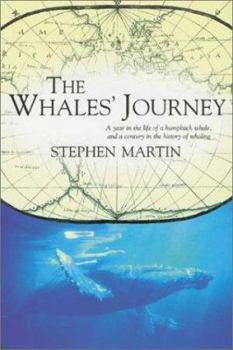The Whales' Journey: A Year in the Life of a Humpback Whale, and a Century in the History of Whaling
From slaughter to sanctuary, this text describes the experiences of the humpback whales as they travel between the cold Antarctic and the warm tropical seas off northern Australia in what is one of... This description may be from another edition of this product.
Format:Paperback
Language:English
ISBN:1865082325
ISBN13:9781865082325
Release Date:April 2002
Publisher:Allen & Unwin Australia
Length:251 Pages
Weight:3.40 lbs.
Dimensions:0.7" x 6.1" x 9.0"
Related Subjects
Endangered Species Mammals Marine Life Nature Nature & Ecology Oceans & Seas ZoologyCustomer Reviews
1 rating
Hunting the humpback
Published by Thriftbooks.com User , 20 years ago
Stephen Martin must not to be faulted for producing a book that's at once depressing and exhilarating. In this account of Humpback whales, their migrations, behaviour and biology, we are reminded of how close we came to eliminating them as a species. The history of whaling in Australasian waters makes a dreary story, but Martin is very careful to avoid judgements in his account. Only illegal whale hunting is subjected to critical comment, something almost universally deplored. More cheering are his descriptions of whale biology, the magnificent journeys the humpbacks undertake from feeding to breeding grounds, the songs, and probably most significantly, the likely recovery of the diminished population. With a firm, straightforward style, Martin traces the movements of whales in the Western Pacific and Eastern Indian Oceans. From their Antarctic feeding grounds, the whales head north to the sub-tropics to breed. After calving and a short period of social training of the offspring, the pods return south in waves of migration. How long humans have been aware of their movements is unknown, but the colonization of this area by Europeans turned hunting from opportunistic to a dedicated commercial enterprise. Truly organized hunting in this region wasn't common until the end of the 19th Century. Once begun, the hunt become highly systematic. Scientists began collecting migration information along with characteristics of the cetaceans for research reasons and in support of the hunt. As their findings began to indicate unsustainable population levels, the calls for curbing the hunt began. After a long campaign, protection programmes were introduced.There are few villains in Martin's scenario. The former Soviet Union reported far lower takes than they actually harvested. One ship, the Olympic Challenger, became notorious for its illegal catches during the 1950s. On the other hand, Martin's heroes are unequivocally identified. William Dawbin from New Zealand went to great lengths to acquire as much information on the humpbacks. His work became the foundation for further studies. One follower was Graham Chittleborough who furthered Dawbin's work and contributing a wealth of his own. Martin rejoices in the protection programmes leading to substantial recovery of humpback populations in recent years. He states the recovery rate has achieved levels of 10% per year at the end of the last century. He stresses that the techniques, alliances and cooperative efforts can be applied in other conservation areas. The model, he notes, is effective and should be extended. His account is enhanced by rough maps, graphics and photographs. A fine bibliography, both popular accounts and scientific works. A solid, readable summary of the humpback life story. [stephen a. haines - Ottawa, Canada]




